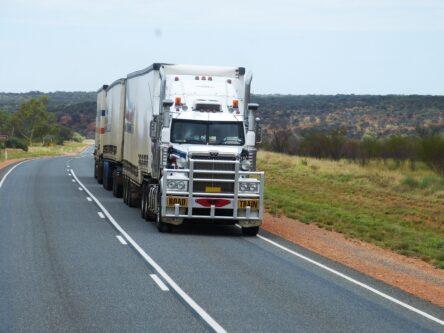Zero tailpipe emissions and quiet battery-powered trucks spreading across industry
By Alan Adler
Using electric trucks for short, repeatable trips to assembly plants is expanding as more OEMs require suppliers to shush the noise and eliminate the diesel exhaust that accompany delivering incoming parts and components.
How did inbound logistics become a thing in an industry where change most often meets resistance? For their own reasons, stakeholders from sustainability-conscious shippers to regulators and OEMs like inbound logistics as a use case for electric trucks.
Was this newsletter forwarded to you? Click here to get Truck Tech via email on Fridays. And catch the latest in major events and hear from the top players on “Truck Tech” at 3 p.m. Wednesdays on the FreightWaves YouTube channel.
“The reason this is a good early adopter is that the trucks stay close to base. But [they] can get a fair amount of miles, at least for the short return-to-base, heavy-duty day cab tractor segment,” said Mike Roeth, executive director of the North American Council for Freight Efficiency (NACFE).
Ideal use case
During my visit to the sprawling Volvo Trucks North America (VTNA) New River Valley Operations site in Dublin, Virginia, this week, plant communications chief Sally Davies told me VTNA has accumulated 95,000 miles of electric driving on short routes bringing parts and supplies to the plant.
https://www.youtube.com/embed/72ayr9Acl2A?feature=oembedVolvo Trucks North America was early to putting electric trucks to work for inbound plant logistics. It’s been a good experience so far.
Watsontown Trucking Co. and Camrett Logistics ordered Class 8 VNR Electric trucks in October 2021 and put them into service on round trips to NRV in December of that year. Ryder System Inc. began operating seven VNR Electric trucks, transporting assembly kits of components for heavy-duty Mack trucks to a kitting facility in Pennsylvania.
‘Manufacturing shuttles’
“We call these manufacturing shuttles,” Roeth said, pointing to Schneider’s execution of electric trucks during NACFE’s Run on Less Electric Depot program last year. Schneider calls this the “next truck up” system. It replaced two-driver slip-seating. “[The driver] returns the truck to the depot, starts charging and jumps into another fully charged truck,” Roeth said. Schneider has 92 eCascadias in its fleet today and a 4.8-megawatt charging facility in El Monte, California, capable of charging 32 trucks at a time.
NFI Industries, an early partner of Daimler Truck North America (DTNA) in piloting Class 8 Freightliner eCascadias, tried this at its Chino, California, depot in early 2020.
DTNA began integrating eCascadias into its own logistics operations in Portland, Oregon, in November. The trucks use the company’s Electric Island heavy-duty truck charging station that opened in 2021 near its Portland headquarters. The four electric trucks initially deployed pick up parts from Pacific Northwest suppliers and deliver them to DTNA’s consolidation center.
‘Sustainable future’
“By integrating electric trucks into our inbound logistics network, we aim to reduce our environmental impact and contribute to a more sustainable future that goes beyond truck development and manufacturing,” Jeff Allen, DTNA senior vice president, operations and specialty vehicles, said in a November news release.
In December, Daimler’s Mercedes-Benz Trucks brand delivered a dozen electric trucks to logistics service. Beginning this quarter, the trucks will complete 50 all-electric inbound logistics runs to its largest plant in Wörth, Germany. The goal is to electrify 100% of delivery traffic to Wörth by the end of 2026.
“Electric trucks can already cover the majority of delivery routes over short and medium distances,” Karin Rådström, CEO Mercedes-Benz Trucks, said in December. “We want to leave the smallest possible carbon footprint across the entire value chain [including] inbound logistics at our Wörth plant.”
Is Mack’s $14.5M Roanoke plant expansion a shot at the UAW?
The timing of the $14.5 million expansion announcement at Mack Trucks’ medium-duty plant in Roanoke, Virginia, was curious. Why announce good news at 5:30 p.m. on a Friday? One explanation: awaiting a signoff from Gov. Glenn Youngkin’s office. The state is ponying up a $255,000 grant from the Commonwealth’s Opportunity Fund after all.
Or, maybe it helped keep the United Auto Workers off guard and perhaps avoided a protest at the ceremonial groundbreaking at the nonunion plant. Remember, the UAW struck Mack for 39 days last fall. The union representing 3,900 workers settled for a contract it rejected earlier.
The UAW struck Mack’s main assembly plant near Allentown, Pennsylvania, on Oct. 8. Four other facilities — a remanufacturing operation, parts depots in Maryland and Florida, and the Hagerstown, Maryland, engine plant also went down.
That stopped most Mack Class 8 truck builds and crimped deliveries to Volvo Trucks North America’s plant in Dublin, Virginia. Those losses contributed to Volvo losing six-tenths of a point of North American market share in 2023.
The Mack strike focused more on economic gains and local issues than adding new jobs. The UAW never publicly mentioned bargaining to organize the Roanoke plant, where the expansion to make diesel and battery-electric medium-duty trucks will add 51 new jobs and Roanoke County incentives totaling $842,420.
Link: https://www.freightwaves.com/news/electric-trucks-find-a-sweet-spot-with-inbound-logistics?utm_source=pocket_saves
Source: https://www.freightwaves.com
















Leave a Reply